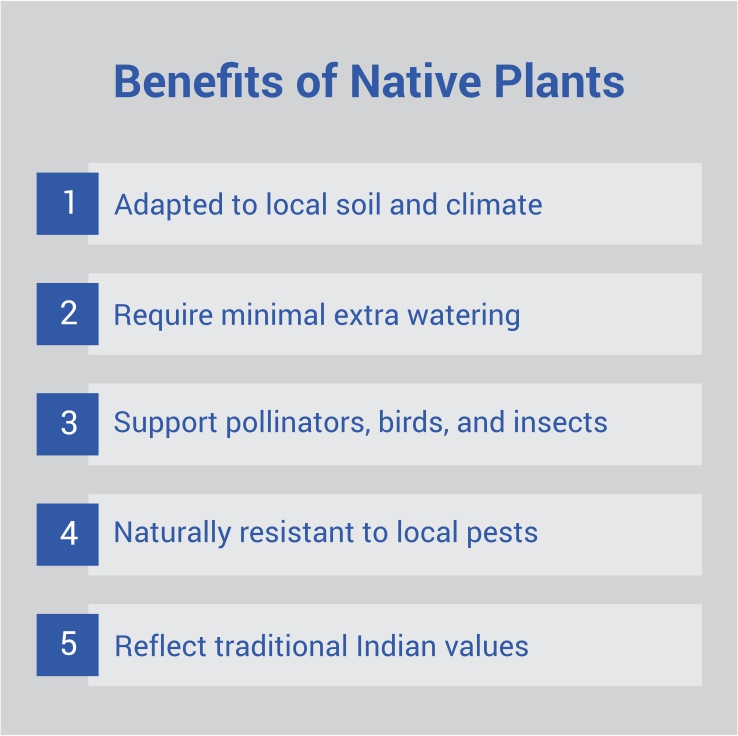In recent years, Environmental, Social, and Governance (ESG) factors have gained increasing prominence in corporate strategies worldwide. For companies operating in India, aligning business operations with ESG standards is no longer optional—it is a key differentiator in securing investor trust, regulatory compliance, and long-term sustainability. Among the many ESG-aligned initiatives, one low-cost, high-impact solution is gaining traction: the integration of native plants into industrial facility landscapes.
This blog explores how integrating native flora into industrial facility management landscapes supports ESG goals, improves biodiversity, conserves water, reduces maintenance costs, and aligns with India’s environmental commitments.
Understanding the ESG Imperative
Before diving into the native plant approach, it's essential to understand how ESG factors intersect with landscaping practices:
- Environmental (E): Involves the conservation of natural resources, reducing carbon footprints, improving biodiversity, and sustainable land use.
- Social (S): Promotes employee well-being, community engagement, and inclusive green spaces.
- Governance (G): Ensures policies that support sustainability goals, transparency, and compliance with environmental regulations.
By incorporating native plants into industrial landscapes, businesses can effectively address all three dimensions of ESG.
Why Native Plants Matter
Native plants are species that naturally occur in a specific region, having adapted to its soil, climate, and ecological conditions over centuries. In India, the diversity of native flora is vast—ranging from neem (Azadirachta indica) and amaltas (Cassia fistula) in the north to palash (Butea monosperma) and gulmohar (Delonix regia) in the south.

Benefits of Native Plants:
- 1. Low Maintenance: Native plants thrive in local soil and climate conditions, requiring less irrigation, fertilization, and pesticides.
- 2. Water Conservation: These species have adapted to seasonal rainfall patterns and need minimal supplemental watering.
- 3. Biodiversity Boost: They provide food and habitat for local pollinators, birds, and insects, supporting ecosystem health.
- 4. Climate Resilience: Native vegetation is more resistant to local pests and climatic extremes.
- 5. Cultural Relevance: Many native Indian plants hold cultural and traditional value, resonating with communities and employees.
ESG and Native Landscaping in Indian Industrial Context
India’s industrial sector, particularly manufacturing, pharma, automotive, oil & gas, and mining, operates across diverse geographies—from arid Rajasthan to the humid Western Ghats. These facilities often occupy vast parcels of land, making them ideal candidates for sustainable landscaping.
By integrating native plants, companies can transform these concrete-dominant environments into green, livable spaces that improve air quality, temperature regulation, and aesthetic appeal, while meeting environmental benchmarks.
How Native Landscaping Supports ESG Goals
1. Environmental Sustainability:
- Water Efficiency: Facilities can reduce water usage by up to 60% by planting drought-tolerant native species such as bougainvillea, curry leaf (Murraya koenigii), vetiver grass, or jamun (Syzygium cumini).
- Pollution Mitigation: Native trees like peepal (Ficus religiosa) and banyan (Ficus benghalensis) are known for high oxygen output and dust filtration, improving on-site air quality.
- Soil Conservation: Native root systems enhance soil structure and prevent erosion—critical for industries near mining sites or riverbanks.
- Carbon Sequestration: Trees like neem and tamarind (Tamarindus indica) sequester significant amounts of carbon dioxide, aiding in climate action goals.
2. Social Impact:
- Employee Wellness: Landscaped areas with native plants create restorative environments that reduce stress, improve mental well-being, and enhance productivity.
- Community Engagement: Involving local communities or NGOs in nursery development, planting drives, or landscape maintenance generates employment and goodwill.
- Educational Opportunities: Facilities can showcase native plant gardens to educate staff and visitors about biodiversity and conservation.
3. Governance and Compliance
- Regulatory Alignment: Integrating native plants helps meet stipulations in India’s Environment Protection Act, 1986, and State Pollution Control Board conditions during environmental clearance.
- ESG Reporting: Native landscaping initiatives can be highlighted in Business Responsibility and Sustainability Reports (BRSR), giving stakeholders measurable insights into green practices.
- Third-Party Certifications: Such efforts contribute positively to achieving certifications like LEED, IGBC, or GRIHA.
Implementation Strategy for Industrial Facilities
Integrating native plants into facility landscapes is not merely about planting a few trees. It requires thoughtful design, long-term planning, and collaboration with experts. Here's a suggested roadmap:
1. Site Assessment
- Conduct a soil, water, and biodiversity audit.
- Identify areas for potential greening (e.g., boundary walls, medians, parking lots, unused land).
2. Native Plant Selection
- Work with ecologists or botanists to select species based on region, climate, and site needs.
- Prioritize species that support local fauna, particularly pollinators like bees and butterflies.
3. Landscape Design
- Incorporate features like rain gardens, bioswales, and green buffers.
- Ensure a mix of ground cover, shrubs, and canopy trees for layered planting.
4. Community Participation
- Engage local workers or SHGs (Self Help Groups) for planting and maintenance.
- Conduct awareness drives among employees about the native species and their importance.
5. Monitoring & Reporting
- Track the survival rate, water usage, biodiversity indicators, and employee feedback.
- Integrate metrics into ESG dashboards and CSR reports.
Challenges and Solutions
Despite the clear advantages, some facilities may encounter barriers:
- Perceived Lack of Aesthetics: Native plants are wrongly assumed to be less ornamental. Solution: Use flowering natives like hibiscus, ixora, or gulmohar for visual appeal.
- Limited Expertise: Landscaping contractors may lack experience with native flora. Solution: Partner with NGOs or ecological landscaping consultants.
- Slow Growth Rates: Some natives may take longer to mature. Solution: Blend fast-growing species for initial coverage while slower natives establish roots.
A Win-Win for Nature and Industry
As industries in India increasingly commit to ESG targets, integrating native plants into landscaping offers a triple win—for the environment, for people, and for governance.
- Environment: Reduced resource use and improved biodiversity.
- Society: Healthier workspaces and community engagement.
- Governance: Stronger compliance and transparency in sustainability metrics.
It’s a simple, scalable, and impactful way to make industrial operations more resilient, responsible, and regenerative.
Final Thoughts
As India marches towards a greener economy with the Net Zero, every square meter of industrial land presents an opportunity to make a difference. Whether it's a sprawling automobile plant in Pune or a compact pharma unit in Hyderabad, integrating native plants is a profound act of environmental stewardship.
Choosing FFServices for your horticulture and landscaping needs ensures expert implementation and maintenance, transforming your industrial site into a green oasis that significantly reduces noise pollution and improves air quality. With our extensive experience and commitment to sustainability, FFServices is your ideal partner for creating a healthier, more productive, and environmentally friendly industrial environment.
Ready to make your industrial facility greener, smarter, and ESG-compliant? Contact us today. Start with native plants. Start with nature. Start today.
Also read: The Economic Benefits of Investing in Industrial Landscaping

